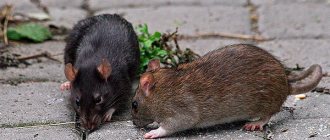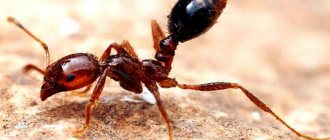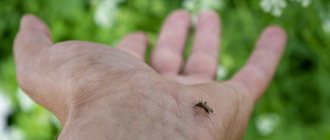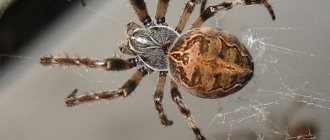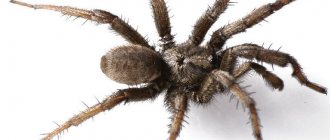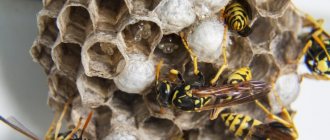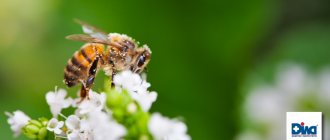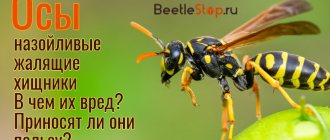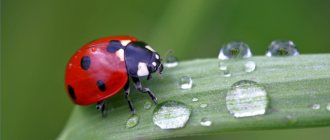Black wasps belong to the pompilidae family. Ground or road insects are medium to large in size, 1.5-5 cm in length. They feed on spiders and bedbugs. An insect bite is dangerous for humans, as an allergic reaction to the poison can be fatal.
The sting of such a wasp is very powerful, capable of easily piercing a thick shell , so no clothing will save the victim from attack. At the same time, in garden plots, stalked bellies destroy spiders and flies, pollinate flowers and plants, which helps people.
Black wasps rarely attack without reason, so if you follow safety precautions, you can avoid meeting this insidious enemy.
"Portrait" of a black wasp
Representatives of the Pompilid family - black wasps - reach a length of 15-50 mm. The chest and head of the insect are dark in color (in most cases black). Depending on the variety, the abdomen may be dark or striped. In this case, the stripes are yellow, orange, white, red and even purple.
The limbs of black wasps are thin and long. The insect has special “ridges” for digging the soil - forming a hole for laying eggs or searching for food. The eyes and antennae are traditionally dark in color. The body is covered with short hairs. The folded wings are located parallel to the body. It is also worth noting the fact that the wings of the black wasp are smoky in color.
Pompylids move feverishly. Making constant movements of their wings, insects zigzag across the surface of the earth or make short flights. A characteristic feature of this type of wasp is the presence of a powerful sting. It is this “tool” that allows black wasps to neutralize prey, including a large spider.
Origin of the species
Insects have no specific scientific definition. Wasps include all stinging stalked bellies belonging to the order Hymenoptera. These insects are not classified as either ants or bees.
At the moment, there is a wide variety of wasp species. These include: road, sparkles, as well as scolias, paper, hornets and so on. All varieties are conditionally divided into:
- Single insects.
- Social insects.
Interesting fact : bees are able to defend themselves only with a sting, while wasps additionally use a powerful jaw apparatus. When in danger, wasps bite quite painfully.
Varieties of black wasps
In the natural environment, there are several varieties of black wasps. Let's consider the descriptions and habitat of the most common subspecies in nature:
Red-bellied road wasp (Anoplius viaticus). This species of black wasps is widespread in central Eurasia. The body length depends on the sex and age of the insect - from 6 to 15 mm. In this case, the chest is painted black, and the abdomen is red. Also, black stripes are clearly visible on the insect’s abdomen. The base of the body is covered with felt, formed with the help of light short hairs. A female red-bellied road wasp preys on a wolf spider. She drags the paralyzed victim into a hole prepared in advance in the ground. It is in such a nest that the female red-bellied road wasp lays her eggs.
Crossbill wasp (Batozonellus Lacerticida). Cross spider wasps prey on cross spiders. It was this characteristic feature that gave rise to the existing name of the subspecies. Insects make nests in a fairly loose substrate. Main distribution area: territories of extratropical Eurasia, North America, eastern borders of Japan. The cross-horned wasp belongs to the large subspecies. The average body length of an insect is 10-20 mm. The body color is black, the limbs are black-red, the wings are brown-orange with a yellow tint. There are characteristic yellow stripes on the abdomen.
Dipogon medium (Dipogon Hircanum). The subspecies of black wasp in question lives mainly in the extratropical zones of Eurasia, as well as in the eastern regions of Kamchatka and Japan. Dipogon middle forms nests inside shoots and branches of trees. This type of wasp feeds on the larvae of various insects. But most of all he loves side-walking spiders. The medium dipogon is characterized by a coal-black color. Moreover, this particular species of black wasps has dark-colored wings. Body length ranges from 5 to 10 mm.
Black and white wasp (Monobia quadridens). The name itself speaks about the body color of this subspecies - black chest and abdomen with white spots and stripes. The average length of an insect is 18 mm. Black and white wasps feed primarily on butterfly larvae. To build nests, they use hives abandoned by tree bees and hollows formed in the skeletal branches of trees.
Description and features
The wasp is brightly colored. The pattern on her body is an alternation of black areas with yellow stripes on the body, as well as a pattern of the same color on the head and six legs.
Usually the bright color of insects in nature often indicates that this creature is poisonous. Wasps are often the name given to all stinging flying insects belonging to the suborder Stalk-bellied insects, with the exception of bees.
All wasps in the photo look the same, just like in real life, but they may differ in size. They have four transparent wings arranged in pairs. In addition, they have a very powerful mouthparts and faceted eyes, which provide the insect with excellent vision.
Coarse hairs can be observed on their paws, allowing such creatures to grip and hold on to a variety of surfaces.
This insect has two ways of fighting against the enemies that the wasp has in nature: mammals, birds, lizards and others.
First of all, the bright colors themselves provide powerful protection. It frightens the enemy, and hunters of various stripes, hungry for prey, lose their appetite when they look at the wasps. It’s just that their color causes unpleasant associations in many living creatures.
But even if one of the predators foolishly attempts to feast on such an insect, after the first misfire, their desires completely disappear. It's just that the sensations are not very pleasant. Therefore, subsequently, enemies stop making attempts to hunt wasps, having developed a warning reflex in themselves.
But in addition to passive methods of protection, these insects also have active methods. And their poisonous sting helps them in this - an autonomous organ, similar to a dagger blade in appearance and principle of action.
It freely penetrates under the skin of the animal, and also comes out without difficulty, having previously injected its portion of poison. This organ is located at the end of the abdomen, like a bee, because it is an insect very similar to a wasp , also capable of stinging.
But the bites of these two poisonous creatures have a number of differences, primarily for themselves. Unlike bees, who die after using their sharp weapon at least once and leaving it in the enemy’s body, wasps remain alive.
When a wasp stings, it does not leave a sting, unlike a bee.
Moreover, they feel great after a bite and are quite capable of making a new attack. In addition, wasps are endowed with the ability to use not only stings, but powerful jaws when attacking. But, like bees, these insects, sensing the smell of poison released by a fellow insect into the enemy’s body, will certainly enter into battle, collectively attacking the object that caused the alarm.
Externally, these insects are certainly similar, but it is not very difficult to distinguish them even by color. If the wasp is yellow and black, then the stripes on the bee’s body have a slightly different hue, with the addition of orange tones.
Pictured is a wasp and a bee
Habitat
Black wasps are also called road wasps or ground wasps. The name itself speaks of the habitat characteristic of this insect species. Pompylids can live in the south, west, east and partly north. The exception is the area where the harsh climate dominates.
Ground wasps live in loose, but at the same time dense soil. To make the “house” reliable and stable, insects prefer soil mixtures of clay, sand and limestone. Accordingly, this type of pompilid gets along well near humans, in particular in the territory of house adjoining, garden and vegetable plots.
Nutrition
The wasp is certainly a useful insect, successfully destroying the larvae of flies, garden and household pests. By feeding on them, wasps turn out to be indispensable, fulfilling their natural function. This becomes especially important in seasons when there are too many harmful insects for natural reasons.
From plant foods, wasps prefer to eat fruits, consuming their pulp and juices, as well as plant nectar. This type of nutrition fully satisfies the needs of working wasps.
But they do not so much strive to satiate themselves as, first of all, to feed the uterus and the offspring it hatches. This is their responsibility. While feeding wasp larvae, they can also feed on their burps if it suddenly turns out that there is not enough food for them.
It becomes especially difficult to find food in the autumn, because during this period small insects already disappear. And here wasps often show extraordinary courage and ingenuity to get food.
Closer to autumn, they can often be seen flying in large numbers near human habitation. They hang around there, trying to eat something from people's tables or some kind of waste.
Characteristic lifestyle
Black wasps live in small colonies, which may contain only one queen. The remaining insects carefully protect the female.
In the spring, pompylids collect nectar. At this time of year, black wasps live in abandoned hollows, as well as among tall flowers and grasses. Towards the end of spring and beginning of summer, insects begin to create burrows. Thus, the average length of the earthen tunnel in which the female plans to lay eggs is 3 cm. To close the entrance to the tunnel from outside penetration, an earthen breast or a small pebble is used.
When going hunting, the female is actively searching for a spider. She drags paralyzed prey along the ground to an equipped nest. It is on the body of the caught spider that the female black wasp lays an egg, which after a few hours transforms into a larva. The full development cycle - from laying an egg to the formation of a full-fledged individual - takes two weeks.
During its two-week development, the larva feeds on the body of the spider prepared by the female. In order for the paralyzed spider to remain alive, the excretory and reproductive systems are initially destroyed by the larva. The respiratory and nervous systems are the last to be eaten. At the end of the cycle, a cocoon is formed from which the black wasp adult emerges. A larva laid at the very end of summer may not have time to complete the entire formation cycle before the onset of cold weather. Therefore, it spends the winter in a hole, having at that time reached the pupal stage.
What does it eat?
Wasps eat
Wasps have a varied diet, depending on several factors: the type of insect, what stage of development it is at and where it lives. People think that wasps don't care what they eat, but in reality this is not the case. Insects feed on meat, fish, berries or sweets. However, these products do not constitute the main diet of insects.
Wasps love soft but liquid food . They eat fruit pulp, drink plant sap, eat berries and drink flower nectar. If possible, wasps may eat human food. Insects search for food thanks to their developed sense of smell. They can easily detect slightly rotten or fermented fruits. Animals also love beer or kvass. Some of the wasp's food is taken to the larvae or queen. Such work falls on the shoulders of working individuals.
Wasp on the hunt
Predatory wasps feed differently. They rarely drink nectar, and most of the time they hunt for other insects. They can even kill small spiders. They feed the larvae with insects. The pre-predatory wasp stalks the potential victim, after which it attacks it with its stinger, paralyzing it. The poison helps keep the victim fresh.
The danger of the black wasp
The sting of a black wasp is considered harmless to humans. In terms of pain, it resembles the bite of a red ant. Characteristic signs of damage include: burning and redness of the skin, rash and swelling, severe itching.
Unfortunately, a black wasp sting poses a serious threat to people with individual intolerance and a tendency to develop an allergic reaction. If immediate medical care is not provided, angioedema, anaphylactic shock and even death are possible. What to do if you are bitten by an insect?
The algorithm for providing first aid to a victim of a black wasp sting will be as follows:
- Hand disinfection. To disinfect, you can use antiseptics or wash your hands thoroughly with soap.
- Rinse the affected area of skin with cold water. This procedure is also necessary to prevent dirt from getting into the bite site.
- Disinfection of injured skin. The use of hydrogen peroxide or chlorhexidine is recommended.
- Applying a cold compress to the bite site.
- Taking an antihistamine: Zodak, Erius, Loratadine, Suprastin and others. The drug and dosage must be determined by a doctor! Also, be sure to carefully read the contraindications and possible side effects.
How to get rid
A wasp sting is most dangerous for children and people with individual intolerance. If the insect nest is located close to your home, then it is better to get rid of it. This can be done both with the help of chemicals and using a mechanical method of control.
Chemical control
Most often, chemicals can be found in aerosol form. The concentrated insecticide does not poison the ground and is practically safe for people.
Most Popular:
- Moskitol. It is necessary to spray strictly in an open space. If you need to spray the hole, then reduce the dose by 2-3 times.
- Gett. A powerful, odorless drug. It has a long-lasting effect, as it remains active for 5-6 months after spraying.
Karbofos and Troapsil are no less popular.
Physical methods
The nest should be removed from the property wearing a protective suit or after pre-treating the area with chemicals. If the nest is located in the ground, then you can dig up the area and pour boiling water over it.
When it is necessary to lure out adults, sweet traps are used. They are made from a plastic bottle and compote or fruit juice. The bottle is cut in half and the upper part is placed neck down into the lower part, where the sweet liquid is poured.
Benefits of black wasp
Black wasps are ideal assistants in the development of agricultural activities. Firstly, this type of insect pollinates plants cultivated in the garden or garden beds. Secondly, wasps feed on aphids, caterpillars, and the larvae of various insect pests. The destruction of harmful insects contributes to the vitality of grown plants and even increases productivity.
Do you want to get rid of pests on your property without using chemical-based products? Black wasps will help solve this problem!
Black wasps, the description and habitat features of which are discussed in our article, provide enormous assistance to humans in the development of agriculture and horticulture. Relatively small pompilids can completely destroy or significantly reduce the number of harmful insects that appear on the site. It is also worth noting the fact that this subspecies of earthen (road) wasps rarely attacks humans for no reason. Most often, an insect stings when the need for self-defense arises.
Preventive actions
Black wasps have a sweet tooth. They love floral aromas and fruits. To prevent them from approaching your home, you should not plant flower beds under the windows of the house. It is also unacceptable to throw away spoiled fruit to rot in the garden.
When harvesting, you should carefully inspect each fruit so as not to bring insects into the house . To prevent bites, women are not recommended to use bright perfumes that can attract wasps during the summer months.
Black wasps rarely attack without reason, usually it becomes their self-defense when a person threatens their life. On the contrary, they help people fight pests in the form of spiders, bedbugs, and flies.
Therefore, there is no need to get rid of them except in cases of individual intolerance to poison. In this situation, in order for the earthen insect to stay away from the home, the number of flower plantings near the house should be limited and the missing products should not be stored for rotting.
Who destroys wasp nests in the ground
What are wasps afraid of?
Nests located in the ground can be destroyed by larger animals or birds, as well as some amphibians (although the latter prefer single individuals). Those that eat ground wasps include:
Of course, this list is far from complete. In general, the likelihood of a nest being destroyed is largely related to its size - for example, only large animals that are not afraid of bites will approach a large dwelling, and most forest inhabitants will be able to destroy smaller or solitary settlements.
Consequences of a bite
The consequences of a wasp sting from this group in the form of pain and swelling in an adult healthy person appear within 2-3 days. A special category includes children, the elderly, pregnant women and people suffering from asthma, allergies, and diabetes.
In this case, the consequences can be very serious and manifest themselves in the form of hypoglycemia, anaphylactic shock, diabetic coma, purulent processes and other equally dangerous signs. A positive result in the fight against these insects can be achieved solely through preliminary preparation.
Mimicry
As already mentioned, syrphids are very similar in appearance to stinging insects - wasps, bees, bumblebees. The hoverflies seem to be camouflaged as them, and their striped black and yellow coloring helps them in this. But upon closer examination, you can notice the difference:
- syrphids have much shorter antennae (for example, a wasp has antennae up to 1 cm);
- they are smaller than wasps, bees, etc. (excluding especially large species);
- they have 1 pair of wings, while the stinging ones have 2.
But even with these minor differences, nothing prevents syrphids from feeling quite at ease and boldly in nature: their external imitation (mimicry, from the English word mimicry - disguise, imitation) of dangerous stinging insects is so believable that few birds risk attacking them, especially if you have already had a sad experience of contact with a wasp. But all this is despite the absolute harmlessness and even some defenselessness of the syrphids.
Nature has endowed these flies with such a coloring, thanks to which they may not be afraid of attacks from enemies. Hence several more popular names for hoverflies: bee-eater, wasp-fly, wasp fly, etc.
Meaning for a person.
Blue mud wasps often make their nests in buildings and therefore cause some nuisance with their presence. But their harmless habits and the use of spiders for breeding, as a rule, compensate for their habitation in buildings. Therefore, you should not destroy blue mud wasps if they have settled in your home; they are useful and feed their offspring with spiders, which can be poisonous. If a blue mud wasp has flown into your home, try carefully covering it with a jar and then releasing it outside. This type of wasp controls the number of karakurt spiders, which are especially dangerous.
Reproduction of pompilids
Large black wasps are solitary; they do not live in colonies and do not build multi-tiered nests. A place for offspring is chosen in the ground, not far from well-trodden roads. Females do not feed the larvae, bringing them food daily. The offspring grows independently, on “live canned food”. Road wasps do not make honeycombs; they use several separate larval chambers as nests. These are short passages dug into the ground, ending in a slight widening.
Information. Some species of pompilids make nests in plant cavities or make them out of clay.
During the breeding season, the female finds and immobilizes spiders on which the larvae will feed. First, she immobilizes the victim, and then looks for a suitable place to burrow. While digging a nest, the female periodically returns to the spider, because it is stolen by ants or other wasps. Next begins the difficult stage of dragging the arthropod into the hole. Some specimens of spiders exceed the size of pompilids.
Prevention
Since black wasps feed on nectar and are considered to have a terrible sweet tooth, you should never put spoiled fruits or foods in one place and allow them to rot. Such a “feast” will certainly attract all kinds of insects, which sooner or later will want to move closer to it.
Interestingly, wasp larvae eat stored food for many days. Moreover, they do this in a strictly defined way, which prevents the victim from starting to deteriorate ahead of time. Then, having gained strength, they make cocoons for themselves.
They spend the winter in them, hibernating, and in the spring, young giant wasps come out.
An interesting fact is that females lay eggs in specially prepared cells, and on previously immobilized spiders. They represent a ready-made food supply for the larvae, which are born a little later.
The aroma of flowering plants, especially flowers, is also attractive to almost all wasps. Therefore, you should not plant these near residential buildings.
Security
Forest wasp
The species is not considered endangered, so it is not in the Red Book. Only a few species are classified as rare in certain areas. For example, the forest wasp is listed in the Red Book of the Moscow Region. This happened due to the fact that wasps of this species are rare in those places. There are not so few insects in the forests.
The main reason for the population decline is human actions. This is considered the main factor, because people destroy wasp nests on their own, considering them pests. From time to time, insects build nests in open areas, so they are damaged due to winds or rains.
The wasp population is declining slightly due to natural enemies. Animals are killed by predators, vermin or birds. At the moment, all habitats of forest wasps are under careful protection by environmentalists. Now it is planned to create new reserves for the protection of insects of this species.
